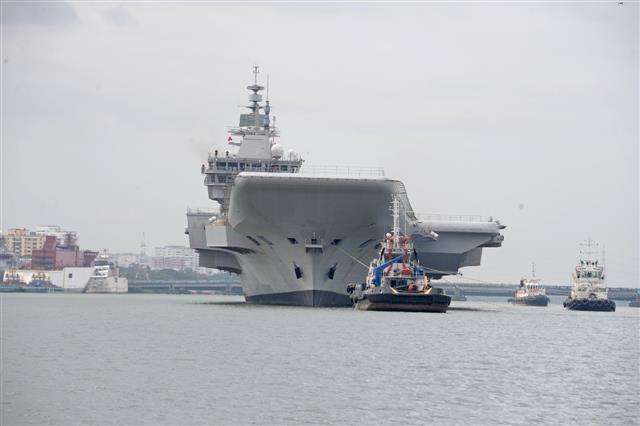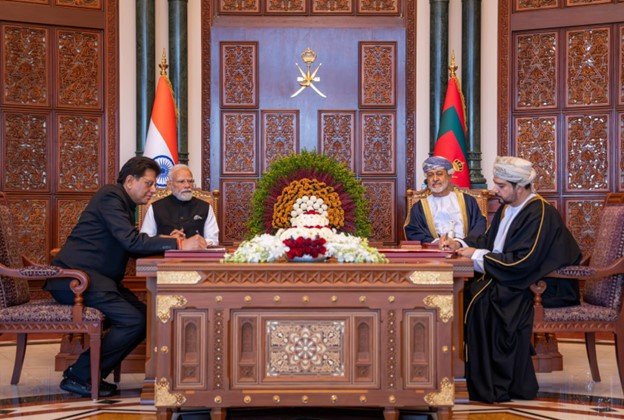India is now the sixth country to make a warship bigger than 40,000 tonnes.
New Delhi: India’s biggest ever indigenous military project – the aircraft carrier INS Vikrant – was commissioned on Friday at the Cochin Shipyard Limited (CSL) Kochi, Kerala, a report by Ajay Banerjee in The Tribune, Chandigarh, says.
India is now the sixth country to make a warship bigger than 40,000 tonnes.
After the commissioning of the warship Prime Minister Narendra Modi termed the INS Vikrant as an “important landmark” and added: “It’s not just a warship, it’s the outcome of 21st century India’s work and determination.”
It’s a floating airfield, the PM said.
Earlier, Modi unveiled the new Naval ensign – the flag that is hoisted atop all warships, ground stations and naval air bases.
The red coloured St Georges Cross has been removed. The Tricolour remains at the left top corner. The Ashoka emblem is retained. The naval anchor is back on the ensign. The Ashok Emblem sits stop the naval anchor. It’s encircled on octagonal seal paying tribute to Maratha ruler Shivaji and his naval force.
After the commissioning, PM Modi said: “If we face challenges, INS Vikrant is the answer. It is the sign of self-reliant India. Howsoever, big the challenges, India can complete the target when we are determined.”
The 45,000 tonne warship will expand the combat arc of the Navy. This will be second carrier in the Naval fleet. The other one, Russian origin INS Vikramaditya, has been operating for the past ten years. Russian made MiG 29K jets –already in the Naval fleet — will be based on its deck and also specialised submarine hunting helicopters.
ALL ABOUT INS VIKRANT, INDIA’S NEW STAR
-1,700 crew including 110 officers.
-This will include women officers.
-Giant automated chapatti makers can roll out 2,000 chappatis in an hour.
-Single meal like lunch requires 120 kgs rice, 100 kgs wheat flour, 120 kgs chicken, 80 kgs vegetables and 100 kgs of pulses.
-India’s first indigenous carrier is 15 stories tall.
-It has four LM 2,500 engines that have 30,000 Horse power each
-The flight deck is 260-metres long.
-The deck is 1,34,000 square feet in size or almost equal to 2 football grounds.
-It can sail for 45 days without refuelling. Its top speed is approx 55 kmph.
-After a take-off has been ‘okayed’ a MiG 29K jet will take just 3 seconds to be airborne from its deck.
-2,400 kms of cabling has been used on board Vikrant for power and communication needs.
-Vikrant onboard power generation — for air conditioning and electricity needs produce 25 MW of power – almost the same as a small hydro dam
-The aircraft carrier is fitted with a dedicated hospital with CT & Ultrasound scanning, X- ray machine, Operation Theatre and even a Dental Clinic.
The INS Vikrant, once deployed, will lead the carrier battle group at sea. It will expand Indian Navy’s arc of ‘surveillance’, provide more attack options at sea while having the ability to match latest warships. Besides own radars, the INS Vikrant will get feed from satellite Rukmini, surveillance planes like the Boeing P8-I and Drones like the Predator.
The Navy has already announced it will start trials for landing and take-off of fighter jets in November. The Long Range Surface to Air Missiles – the Barak – are also to be fitted.
Sources said the Vikrant was expected to be operationally deployed in eight months or so from now.
The Vikrant has been built with state-of-the-art automation features and is the largest ship ever built in the maritime history of India. The indigenous aircraft carrier is named after her illustrious predecessor, India’s first aircraft carrier which had played a vital role in the 1971 war.
Indian Navy’s in-house Warship Design Bureau has designed it. It has a large number of indigenous equipment and machinery, involving major industrial houses in the country as well as over 100 MSMEs.
INS Vikrant’s flight deck will be STOBAR (Short Take-Off But Arrested Recovery) configuration with a ski-jump. The fighter jet will approach deck at 240 kms per hour. A set of three, ribbed- steel ‘arrestor wires’ – each is one inch thick—will pop up across the 60 metre wide deck. The undercarriage of the jet has a tail hook, that gets ‘arrested’ in wires and brings the aircraft to stop within 90 metres of touchdown. For taking-off, there is a 14-degree inclined ramp shaped like ski jump to give it a lift.
“Fighter jet trials will commence in November this year,” Indian Navy officials said a press conference last week.
Earlier, at the Defence Minister, Rajnath Singh, said: “The Vikrant is an icon of country’s power and determination. It will increase capability of Indian Navy”.
“Vikrant is an assurance to our friends that we want free, open inclusive Indo-Pacific,” the Defence Minister said.
Indian Navy Chief Admiral R Hari Kumar said the Navy looks to be totally self-reliant by the time the country celebrates 100 years of independence.
Chairman and Managing Director Cochin Shipyard Madhu Nair said the warship is a representation what the nation can accomplish.
*********************************************************************
Readers
These are extraordinary times. All of us have to rely on high-impact, trustworthy journalism. And this is especially true of the Indian Diaspora. Members of the Indian community overseas cannot be fed with inaccurate news.
Pravasi Samwad is a venture that has no shareholders. It is the result of an impassioned initiative of a handful of Indian journalists spread around the world. We have taken the small step forward with the pledge to provide news with accuracy, free from political and commercial influence. Our aim is to keep you, our readers, informed about developments at ‘home’ and across the world that affect you.
Please help us to keep our journalism independent and free.
In these difficult times, to run a news website requires finances. While every contribution, big or small, will makes a difference, we request our readers to put us in touch with advertisers worldwide. It will be a great help.
For more information: pravasisamwad00@gmail.com








